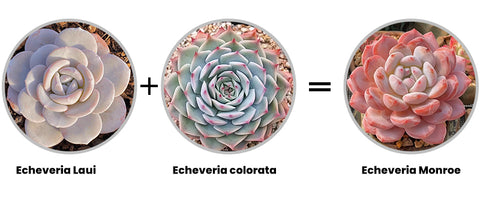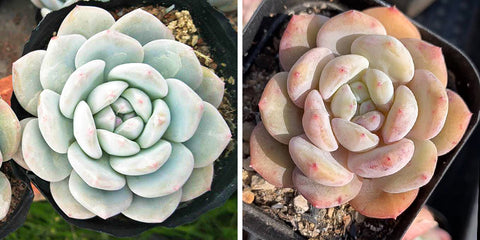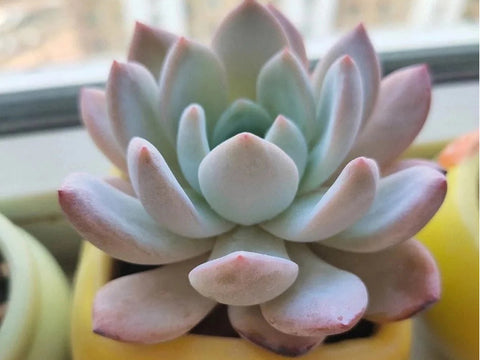Echeveria Monroe is one of the most popular succulents, showcasing a low, lotus-like growth with plump leaves tightly clustered. The hues of its leaves undergo a dreamy transformation, ranging from blue-white to orange-red. In spring, Echeveria Monroe graces us with pink or orange-hued blooms, truly living up to its namesake, Monroe.
As a Korean hybrid, Echeveria Monroe is said to be a crossbreed between Echeveria Laui and Echeveria colorata. Consequently, while inheriting Echeveria Laui's farina, Echeveria Monroe boasts more slender leaves than its predecessor.

Embraced by succulent enthusiasts for its low-maintenance nature, this article aims to guide you on how to care for Echeveria Monroe:
Lighting
Echeveria Monroe can thrive in direct and indirect light, allowing you to care for it indoors or outdoors. However, indoor lighting conditions usually fall short compared to outdoor settings, potentially resulting in your Echeveria Monroe retaining a consistently green color with elongated and thinning leaves. To prevent this, consider the following tips on lighting for Echeveria Monroe:

1. During spring and autumn, expose Echeveria Monroe to ample outdoor sunlight (at least 8 hours).
2. For indoor care, provide a minimum of 10 hours of indirect light or 12 hours under a grow light.
3. In summer, provide partial shade to prevent sunburn.
Temperature
Being a soft succulent, Echeveria Monroe can survive in temperatures ranging from 32 to 95℉. The ideal temperature for most Echeveria succulents is between 60-75℉. As the temperature fluctuates, especially with significant day-night variations, Echeveria Monroe will gradually transition from blue to orange, showcasing a remarkable color change. Therefore, Echeveria Monroe is most prone to coloring in spring, autumn, and early winter, offering delightful surprises, especially for those cultivated outdoors.

Watering
With its thick leaves and strong water retention, Echeveria Monroe doesn't demand frequent watering. Following the soak-and-dry method, wait a few more days after the soil completely dries before thoroughly watering when the bottom leaves soften. When watering, consider the following:
1. In summer, maintain ventilation after watering, and consider using a fan.
2. Avoid pouring water directly onto the leaves to avoid breaking Echeveria Monroe's farina. You can try the bottom watering.
3. In winter, refrain from watering when temperatures drop below 32℉ to prevent damage to the succulent's root system from freezing.
You may wonder: How to care for succulents in winter.
Soil and Pot
Echeveria Monroe thrives in well-draining succulent soil. Adjust the soil composition based on the size of the succulent:
1. For small succulents under 4 inches: 50% succulent potting mix + 50% perlite.
2. For mature succulents over 4 inches: 30% succulent potting mix + 70% perlite.
3. For indoor care, increase the perlite content in the soil.
Choose a succulent pot with drainage holes, with a diameter 1.5 times larger than the succulents.
Pest Control
The most common pest is mealybugs. It might be a mealybug infestation if you notice white fluffy residue or tiny white bugs on Echeveria Monroe. Promptly clean affected areas with a cotton swab dipped in alcohol. In severe cases, treat with a systemic insecticide and repot succulents.

Propagation
Echeveria Monroe can be propagated through leaf cuttings. Follow these steps:
1. Gently wiggle and detach a complete leaf from the bottom of Echeveria Monroe.
2. Place the leaf in a dry container in a bright, well-ventilated area.
3. Transplant the leaf into a seedling tray with prepared soil once roots appear.
4. Cover the roots lightly with soil and water after a week.
You may wonder: How to propagate succulents from leaves.
Echeveria Monroe and Its Similar Varieties
Echeveria Monroe has close counterparts, such as Echeveria Orange Monroe and Echeveria cv. 'Laulindsayana,' Echeveria laui, and Echeveria 'Snow Angel'.
Let's explore their connections and distinctions:
Echeveria Orange Monroe: This is essentially the same variety as Echeveria Monroe. When Echeveria Monroe peaks, it displays a striking orange hue, often referred to as Echeveria Orange Monroe.
Echeveria cv. 'Laulindsayana': Another distinct variety, Echeveria cv. 'Laulindsayana' features more elongated leaves than Echeveria Monroe, with thicker white frost on the leaf surfaces.

Echeveria laui: As mentioned earlier, Echeveria laui serves as the parent species for both Echeveria Monroe and Echeveria cv. 'Laulindsayana.' It boasts the roundest leaves and the thickest farina.
Echeveria 'Snow Angel': A hybrid of Echeveria Monroe and Echeveria laui, Echeveria 'Snow Angel' emphasizes the thick farina from Echeveria laui's genetics, resulting in a predominantly white coloration.

























